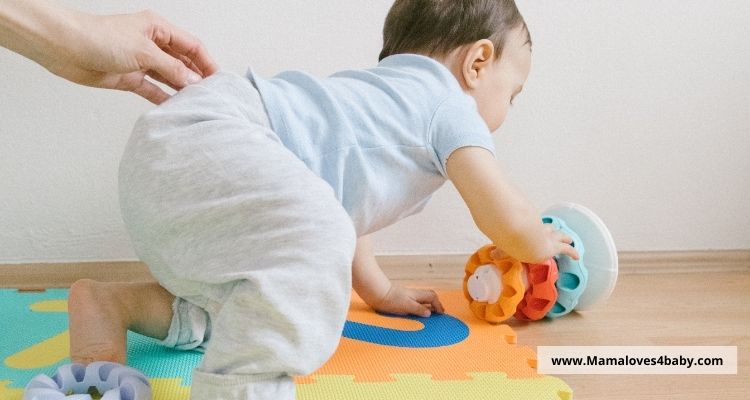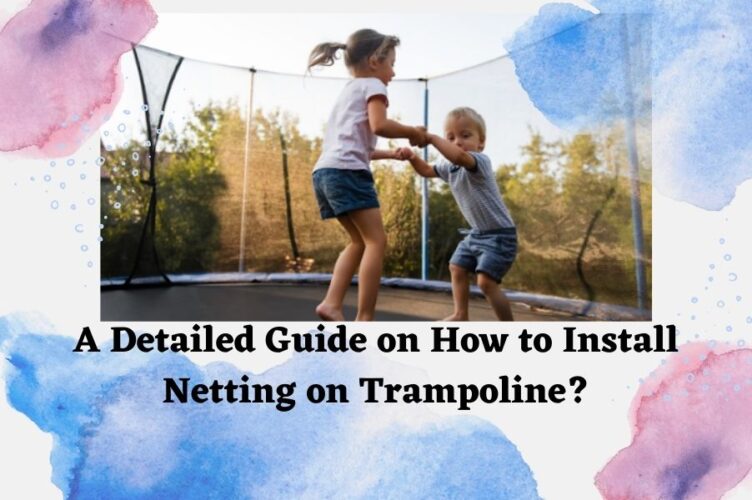Want to see your baby crawl? Wait, you are not alone. You are among many new parents who are eagerly waiting for this time. Some babies may find crawling a tough nut to crack but indeed a fantastic stage to get through. For the parents, also seeing their baby crawl can be nothing less than a treat to the eyes and a moment of joy that they will love to remember.
You need not worry if your baby is delayed. He might have learned other skills before. Instead, you should emphasize on your part as to how to help baby crawl on knees? In this context, keeping in mind specific considerations varying from one child to another is essential. Furthermore, introducing certain activities to encourage crawling can support them to develop this skill.

How to help baby crawl on knees through activities to encourage crawling
Parents always want to see their babies learn new things and regularly develop and practice new skills. It is not only delightful but also an assurance of their child’s physical and mental stability.
Babies often start to crawl and creep by about nine months of age. To assist your child in innovating this ability within him and helping him achieve this milestone, you can introduce certain activities that might encourage him to crawl.
1. Tummy time
Give your baby sufficient time to lie down on the tummy. You can start this in the initial months of your baby as this will develop a habit to enjoy some tummy time that will later help crawl.
Even if your baby feels frustrated in this position, you can try this in short intervals. Tummy time will make them practice raising their heads, necessary for building the neck, shoulder, and arm muscle strength.
Suppose your baby doesn’t like tummy time at all. In that case, you can try engaging them with some toys, placing them on a soft pillow, singing a lullaby, giving a massage, placing a sensory blanket underneath, or a water mat to help make this a pleasant experience. It is one of the best and most practical activities for babies 0-6 months.
2. Hands down position

You can start by getting your baby into a hands-down position by placing something beneath the lower body to pull it up. It will let his hands down, putting weight into the arms, thereby getting him to crawl. This activity will enable him to know and analyze this position.
You can use a pillow, a cushion, a rolled, lightweight blanket, or any other material that you find helpful for this purpose.
3. Baby proof your house
Before your child starts to crawl, the first thing that you should do is to babyproof your house. As soon as the baby begins to move, he wants to pick up every possible thing in his range, climb over, and get hit by nearby objects. It means he is open to accidents now. It would be best if you never underestimate the strength and speed of your child.
Therefore to ensure the safety of your baby, you must take into consideration the following:
- Clear the things that can cause choking
- Block the ends of staircases
- Secure electrical sockets
- Cover the sharp edges of furniture
- Keep medicines, detergents, and other cleaning materials out of your baby’s reach
- Prepare for the first aid kit.
3. Give your baby ample space to move
One way to help a baby crawl is to give him sufficient space to roam about. You can keep exciting and attractive things and toys that he would like to explore. Make sure the place is comfortable and safe for your baby.
Related: Best Playpens For Babies
4. Make your baby wear comfy clothes
When you want to make your baby learn something new, the first thing you need to do is to make him comfortable. If the floor of the area where your baby is learning this new skill is not smooth or carpeted, then you should make your baby wear a full sleeve shirt and full-length pants. You can also use knee protection pads for your baby. This effort of yours will make it easier for him to begin with.
5. Accompany while baby starts crawling
Try to play with your baby on the floor and show him how to crawl. Your baby might imitate you and learn early. Sometimes you need to lead your baby, and through this way, your baby will get a guiding partner, which would undoubtedly make this learning practice easier and more enjoyable for him.
6. Put a mirror in front of the baby
Putting a mirror in front of your baby will help increase the tummy time and support the baby’s development in many other ways. When a baby sees his reflection, he gets intrigued as to whom he sees the reflection of? How are his actions and gestures being replicated? And countless questions come into his mind that inspires him to sit, roll, stand, crawl, etc.
Hence this activity support babies:
- visual tracking
- improves hand eye coordination
- increases the attention span
- enhances fine motor skills
- Develop strong gross motor skills.
7. Motivate your baby
Babies have an inborn desire to move. Little extra motivation can help them to reach their important milestones. Try to applaud your baby’s tiniest efforts when taking a few steps, be it worthy or not. Stimulation helps change behaviors, develop skills, explore new ways, make progress and improve engagement.
The most considerable encouragement for your baby will be in the tone of your voice, your excitement for him to succeed, and in the comforting words used for his efforts.
8. Place toys a little far from your baby

Another activity for crawling babies would be to place toys or something attractive at a slight distance from a baby to which he tries to reach out. This will help him stretch his own hands, arms, bend one leg and turn around knees, somewhat switching to a crawling position to take hold of it. The toy should be in the baby’s reach, so he may not think of it as unreachable. Your objective is to motivate them, not to discourage them.
9. Put your baby on all 4’s through some support
Try to encourage your baby to crawl on all fours. Place him on your legs, supporting his body weight, and get him on his hands and knees. It will let him explore this body equally and feel the pressure on joints, fingers, wrists, and elbows. This will help babies crawl and let them develop the strong muscles required to grasp and handle objects. This method of beginning crawling using both hands and knees is considered the best.
10. Make an underpass
To make things more interesting, you can make a tunnel for him to pass by. You can do this using a table or chairs in your house. You may sit on one end and cheer your baby to come to you from the other end.
Is baby crawling important?

Crawling plays a vital role in muscle and brain development. It contributes to
- Strengthening the baby’s neck muscles, letting him hold his head upright.
- Developing muscle strength in arms, hands, legs, and fingers.
- Improving general coordination
- Sending sensory stimulation to the parts of the body
- Firming up wrists
- Enhancing shoulder, torso, and hip muscle strength
Is it bad for babies to skip crawling?
There is a possibility that your baby is a non-crawler which is fine. Still, it may also impose some risks later in life involving weak muscle strength, less coordination and concentration, difficulty executing fine motor skills, and delayed walking. Not necessarily babies who skip crawling will have to face these problems, but some may have to deal with a few.
Causative factors in delayed crawling
You need to consider some factors if you are anxiously waiting for your baby to crawl.
Normal factors:
- Overweight baby
- Non-crawler baby
- Baby wearing uncomfortable clothes
- Premature baby
- Baby getting less tummy time
- Given less chance to crawl
Alarming factors:
- Stiff baby syndrome
In this condition, a baby cannot stretch his legs and arms. The muscles become incredibly stiff, making it difficult for the baby to move. If diagnosed at an early age, therapy can be beneficial. However, regular home massages can provide relief by releasing tension in some cases.
- Weak legs of baby
If the baby’s legs are weak, it can also delay his movements from one place to the other. A kid may suffer from this syndrome at birth or some later stage in life. It would be pretty obvious to know because this condition affects muscle strength and the functioning of the brain.
- Hip problem
Genetic hip displacement can cause a baby to take longer to begin crawling.
- Cerebral palsy
It is a child’s development disorder. A baby suffering from this disorder may face a delay in many other things except for crawling. They may lack behind in showcasing other motor skills as simple as smiling, moving eyes, indicating a severe problem.
- Weak shoulder muscles
Stiff muscles, rigid movements, difficulty swallowing, and mental problems indicate that the baby has weak neck muscles. The strengthening of which will support the baby to progress.
Types of baby crawls
There are many baby crawling styles. Given the ease and preference of your baby, he may follow any of the following:

- Classic crawl
Putting weight on hands and knees, the baby moves forward using one arm along with the opposite knee at once.
- Bear crawl
In bear crawl, the crawling baby tends to move forward using their hands and feet as in classic crawl, but without bending their elbows and knees, keeping them straight like a bear.
- Belly crawl
Belly crawl is like a military crawling style, also called commando crawl. Babies who adopt this style move by sliding their tummies against the floor. Such babies proceed using hip muscle strength, shifting the body weight on either one side and letting the opposite side’s leg bend up.
It is pretty standard among babies. They usually start commando crawling around the age of 8 months. Most babies may shift to other crawling forms before walking, while others may stick to commando crawl.
- Bottom babies scoot
In this form babies start crawling while sit on their bottoms and move around in a forward or backward direction with the help of their arms.
- Crab crawl
In this baby crawling style, many babies tend to push themselves either sideways or backward using their hands.
- Rolling crawl
The baby rolls on the floor to reach his goal. For such babies, this becomes the primary style to move around. and it is perfectly normal.
What is the difference between creeping and crawling?
In creeping vs crawling, When a baby uses his hands and feet while the tummy remains in touch with the floor, is called as crawling. In creeping, a baby uses his hands and knees while the stomach is off the floor. Baby creeping can further explain when a baby moves around by lifting the belly from the floor, putting weight on the hands and knees, and keeping the hands straight.
So for those of you who are wondering what army crawl is? The crawling stage is likely to happen before creeping babies begin army crawling have greater coordination and strength in the body’s upper portion. It is a transitional phase for a baby to shift their hands and knees to crawl.
Now the question arises as to when doing a baby’s army crawl? Babies start crawling between 7 and 10 months.
What is asymmetrical crawling?
It is when your baby uses one knee, the foot and opposite leg to begin crawl. This pattern is not typical and should be avoided, affecting a child’s coordination, muscle strength, and vision. Now the question is how to fix asymmetrical crawling? You can correct his posture by making your baby practice climbing over hurdles using cushions or pillows.

What should you not do? Avoid baby bouncers, baby seats, and baby walkers. Putting your baby in bouncers, walkers, baby seats, and carriers out of need and for a prolonged time is something you should avoid. It not only lessens the floor time of your baby but also delays muscle development.
Avoid putting too much pressure. Do not press your kid too much for tummy time. Every kid is somewhat different in terms of the pace of growth. Maybe it is not the right time for babies to learn crawling or for babies to develop a specific skill. So you should avoid forcing him as this can hinder his learning process.
Conclusion
The babies crawl anytime around 6 months to 13 months of age. Being different from one another, they may adopt other baby crawling styles. You need to keep track of this development in your child and encourage them to move as there lie many benefits in learning this skill.
Many parents may also wonder, are activity centers good for babies? Yes, you can engage your baby but use this alternative as little time as possible as they may also enforce some physical developmental problems. There are many other activities for babies 0-6 months, as explained earlier, that will not only help them to explore the new world but also build a base for achieving the milestone ahead. I hope this article helps you to know how to encourage baby to crawl, let me know if you have more thoughts on it.
However, if your baby does not attempt to crawl at all by about ten months of age, it is time to consult your doctor.
How can I strengthen my baby’s legs to crawl?
One way is to lift your baby off the ground. Hold him from the upper body to support his weight but let his feet touch the ground. It will help him learn the gesture of walking, strengthen his legs, and explore this body position. The second is to give a gentle leg massage. Regular massages support muscle development.
What delays a baby from crawling?
Most often, less tummy time or lack of motivation hinders your baby’s crawl. Let them make a move when they want something. Please put it in their reach but at some distance. This will inspire him to babies who skip crawling altogether.
What causes asymmetrical crawling?
Babies have fundamental irregularity in their hips, muscles, and body awareness show this pattern of crawling. Sometimes it is linked to autism in babies.
When can a baby start using an activity center?
You can introduce your baby to an activity center at about six months of age. Before this age, a seated activity center is not recommended as it may delay your baby’s physical development.


